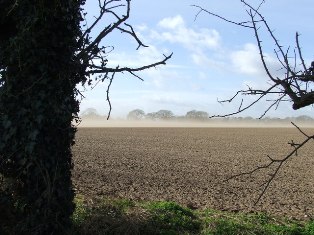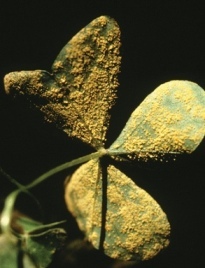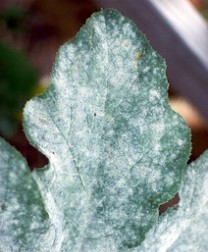
Interactions
Plants are much more active than many people give them credit for. Even though plants are sessile they still interact in a multitude of different ways with organisms and their habitat!
Sage like any other plants has roots, and roots in a plant do much more than take in water and provide the plant with structural support. Roots can help reduce soil erosion! When the roots burrow into the soil, it holds the soil together and prevents it from being blown or washed away. The foliage of the plant above ground also buffers wind speed and helps prevent soil from blowing away. In many places where there has been deforestation, wild fires, or poor farming, there are usually signs of soil erosion. A historic example of soil erosion is The Dust Bowl.
Pollinators

Many plants rely on wind pollination in order to sexually reproduce with one another. The energy cost for producing a large amount of pollen grains is quite costly. Since many of the pollen grains released from the flower won't reach another plant, many of the them will be wasted. Because of this, plants have developed colorful flowers to attract species that could possibly carry their pollen. Sage specifically attracts some species of butterflies and bees. Once one of these species lands on the plant, they then acquire some of the plants pollen from the anther. When they land on another plant the pollen is transferred to the stigma of the other plant resulting in successful pollination.
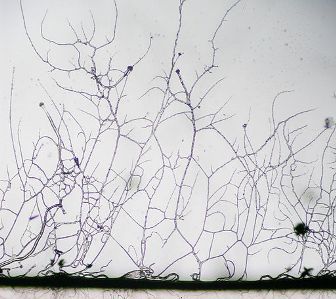
Endomycorrhizae
Endomycorrhizae is an interaction that sage, and almost any other
land plants have that is between the plant and a fungus from the
phylum Glomeromycota. In fact over 80% of vascular plants have this
relationship with fungus! This type of fungus colonizes in the roots
of the plants and increases water and nutrient uptake in the plant
and also receives sugar from the plant. This additional
fungus is able to absorb more
nutrients because of the additional
surface area it provides. This surface area comes from the fungus'
specialized cells that are interconnected thread like cells called hyphae. A whole network of hyphae is referred to as a mycelium. The
mycelium is the part of a fungus that you can't see and it usually
beneath the ground or in a certain substrate. In this case, the
substrate the fungus is in is the root of the plant. This
is a type of symbiotic relationship called mutualism, where both of
the organisms in the relationship benefit from one another. The
resulting increased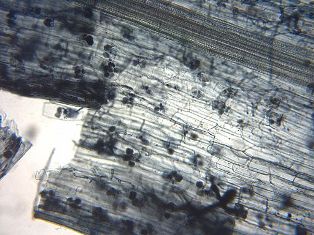 water and
nutrient uptake caused by the fungus
results in improved plant productivity. In addition, in medicinal
plants such as sage, mycorrhizal fungus increased the amount of
chemicals that the plants made. So next time you see a plant,
appreciate that a fungus most likely played a part in making that
plant successful!
water and
nutrient uptake caused by the fungus
results in improved plant productivity. In addition, in medicinal
plants such as sage, mycorrhizal fungus increased the amount of
chemicals that the plants made. So next time you see a plant,
appreciate that a fungus most likely played a part in making that
plant successful!
Endophytes
Endophytes are an example of another awesome interaction between sage and fungus! This is a mutualistic symbiosis where a fungus resides in a plants leaf! Nearly all plants have endophytes in their leaves and the fungus in the leaf produces substances that can deter predators and prevent the plant from being attacked. These endophytes can also produce substances that can have potential use in medicine and the farming industry. In fact many natural medicinal drugs on the market today are derived from secondary metabolites made from the fungus plant interactions.
People
For many years people have been interacting with sage by using it as a flavoring for food and using it to help aid against inflammation making it a sustainable and useful food. Aside from sages native habitat, people cultivate sage all over the world in order to gain its health benefits and yummy taste. The essential oils that sage has give it its distinctive taste anti inflammatory properties, and antioxidant properties that make it so important to people.
Essential oils
The essential oils produced by sage aren't just important to us. They act as a defense for the plant, exhibiting antibacterial, and antifungal properties. In addition, it deters herbivores and insects from munching on the leaves.
Common Rust
Like humans, plants have to deal with all sorts of pathogens including bacteria, fungus, and viruses. Though many common ailments in plants are fungal infections. A very common pathogen is the Common Rust or Phragmidium spp., which is a fungus. Symptoms of common rust are raised spots of spore masses on the underside of leaves and stems (as seen in the picture to the right). These spots then turn yellow and black and can cause leaf death. This infections occurs in periods of high humidity, high heat and low light. These conditions are perfect for a fungus to spread.
Another common plant disease that is has caused sage troubles is the Powdery Mildew. This plant disease is a fungal infection. As seen in the picture on the right, symptoms of this disease include blister like spots on leaves that cause the leaf to curl and a powdery white growth over the leaves. This is what gives the disease its name.
There are many other plant diseases. Click here to see a short list of just some of the common plant diseases.
Do you want to see how other plants interact with their environment? If you said yes, then check out the Apple Guava!
To explore some interesting traits that sage has, continue to Facts.
To see many more interesting and unique organisms, check out the Multiple Organisms web page.
